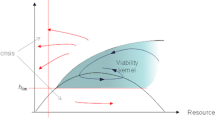Abstract
Terrestrial and marine biodiversity provides the basis for both ecosystems functioning and numerous commodities or services that underpin human well-being. From several decades, alarming trends have been reported worldwide for both biodiversity and ecosystem services. Therefore the sustainable management of biodiversity requires a double viewpoint balancing ecological conservation with the welfare of human societies. Understanding the underlying trade-offs, synergies and interactions imposes the development of interdisciplinary researches and methods. In that respect, bio-economic or ecological economic modeling is likely to play a major role. The present paper intends to elicit the key features, strengths and challenges of bio-economic approaches especially in mathematical and computational terms. It first recall the main bio-economic methods, models and decisional instruments used in these types of analyses. Then the paper shows to what extent bio-economic sustainability lies between equilibrium, viability and optimality mathematical frameworks. It ends up by identifying new major challenges among which the operationalization of ecosystem based management, the precautionary principle and the implementation of governance are especially important.




Similar content being viewed by others
Notes
International Panel for Biodiversity and Ecosystem Services: http://www.ipbes.net/.
References
Aubin J-P (1990) A survey of viability theory. SIAM J Control Optim 28(4):749–788
Baumgartner S, Quaas MF (2009) Ecological-economic viability as a criterion of strong sustainability uncertainty. Ecol Econ 68:2008–2020
Béné C, Doyen L (2008) Valuing biodiversity and the contribution of species richness to ecosystem sustainability. Ecol Econ 68(1–2):14–23
Béné C, Doyen L, Gabay D (2001) A viability analysis for a bio-economic model. J Ecol Econ 36:385–396
Bjørndal T, Conrad MJ (1987) The dynamics of an open access fishery. Can J Econ 20(1):74–85
Butchart SH et al (2010) Global biodiversity: indicators of recent declines. Science 328(5982):1164–1168
Byron KW, Nichols JD, Conroy MJ (2002) Analysis and management of animal populations. Academic Press, New York
Cissé A, Gourguet S, Blanchard F, Doyen L, Pereau J-C (2013) A bio-economic model for the viable management of the coastal fishery in French Guyana. Environ Dev Econ 1–25
Clark CW (1990) Mathematical bioeconomics, 2nd edn. Wiley, New York
Cunningham S, Bostock T (2005) Successful fisheries management: issues, case studies, perspectives. Eburon Publishers, Delft
DeLara M, Doyen L (2008) Sustainable management of natural resources: mathematical models and methods. Springer, Berlin
Doyen L, DeLara M (2010) Stochastic viability and dynamic programming. Syst Control Lett 59(10): 629–634
Doyen L, Martinet V (2012) Maximin, viability and sustainability. J Econ Dyn Control 36(9):1414–1430
Doyen L, Pereau J-C (2012) Sustainable coalitions in the commons. Math Soc Sci 63:57–64
Doyen L, Thébaud O, Martinet V, Gourguet S, Béné C, Bertignac M, Fifas S, Blanchard F (2012) Stochastic viability to ecosystem-based management of multi-species fisheries. Ecol Econ 75:3242
FAO (2003) The ecosystem approach to fisheries. FAO technical guidelines for responsible fisheries 4, Suppl 2. FAO, Rome, 112 pp
Gourguet S, Macher C, Doyen L, Guyader O, Thébaud O (2013) Bio-economic modeling for the viable management of mixed fisheries. Fish Res 140:46–62
Gutiérrez NL, Hilborn R, Defeo O (2011) Leadership, social capital and incentives promote successful fisheries. Nature 470:386–389
Hardin G (1968) The tragedy of the commons. Science 162(3859):1243–1248
Hardy P-Y, Doyen L, Béné C, Schwartz AM (2013) Food security-environment conservation nexus: a case study of Solomon Islands’ small-scale fisheries. Environ Dev. http://www.sciencedirect.com/science/article/pii/S2211464513000584
Heal G (1998) Valuing the future, economic theory and sustainability. Columbia University Press, New York
Larkin SL, Alvarez S, Sylvia G, Harte M (2011) Practical considerations in using bioeconomic modelling for rebuilding fisheries. OECD Food, Agriculture and Fisheries Working Papers
Loreau M et al (2001) Biodiversity and ecosystem functioning: current knowledge and future challenges. Science 294(5543):804–808
Martin S (2004) The cost of restoration as a way of defining resilience: a viability approach applied to a model of lake eutrophication. Ecol Soc 9(2):8
Millenium Ecosystem Assessment (2005) Ecosystems and human well-being. Island Press, Washington, DC
Morris WF, Doak DF (2003) Quantitative conservation biology: theory and practice of population viability analysis. Sinauer Associates, Sunderland
Mouysset L, Doyen L, Jiguet F (2012) Different policy scenarios to promote various facets of biodiversity. Ecol Indic 14:209–221
Mouysset L, Doyen L, Jiguet F (2013) Economic risk aversion to promote biodiversity. Ecol Appl 23:96–109
Mouysset L, Doyen L, Jiguet F, Allaire G, Leger F (2011) Bio economic modeling for a sustainable management of biodiversity and agriculture. Ecol Econ 70(4):617–626
Pereau J-C, Doyen L, Little R, Thebaud O (2012) The triple bottom line: meeting ecological, economic and social goals with Individual Transferable Quotas. J Environ Econ Manag. 63:419–434. doi:10.1016/j.jeem.2012.01.001
Schaefer MB (1954) Some aspects of the dynamics of population important to the managment of the commercial marine fisheries. Bull Int Am Trop Tuna Comm 1(2):2656
Swanson TM (1994) The economics of extinction revisited and revised: a generalized framework for the analysis of the problems of endangered species and biodiversity losses. Oxford Economic Papers New Series, vol 46. Special Issue on Environmental, Economics, pp 800–821
Thébaud O, Smith T, Doyen L, Planque B, Lample M, Mahevas S, Quaas M, Mullon C, Vermard Y, Innes J (2013) Building ecological-economic models and scenarios of marine resource systems: workshop report. Marine Policy. doi:10.1016/j.marpol.2013.05.010
Worm B et al (2009) Rebuilding global fisheries. Science 325(5940):578–585
Acknowledgments
This work has been carried out with the financial support of the ANR (French National Research Agency) through the ADHOC and FARMBIRD programs. The support from IHP (Institut Henri Poincaré) in Paris during the trimester “mathematics of bio-economics” in the framework of Mathematics of Planet Earth 2013 initiative was important.
Author information
Authors and Affiliations
Corresponding author
Rights and permissions
About this article
Cite this article
Doyen, L., Cissé, A., Gourguet, S. et al. Ecological-economic modelling for the sustainable management of biodiversity. Comput Manag Sci 10, 353–364 (2013). https://doi.org/10.1007/s10287-013-0194-2
Received:
Accepted:
Published:
Issue Date:
DOI: https://doi.org/10.1007/s10287-013-0194-2




